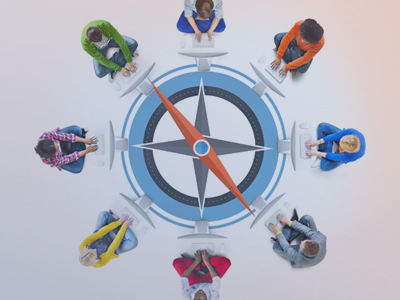AFFINITY BIAS
Also known as similarity bias, affinity bias is the tendency to gravitate toward others with whom we share similar backgrounds, interests and experiences. This might include people who went to the same or similar colleges or universities or come from the same city or state. It might include looking more favorably on those with similar-sounding, less “ethnic-sounding” names. This can lead to excluding diverse candidates who could bring new ideas and perspectives to your organization.
Battling Affinity Bias: Consciously note when you find similarities with a candidate or employee. Once identified, make sure you eliminate these attributes as criteria for hiring or receiving an assignment or promotion. Focus instead on qualifications that have everything to do with achieving your goals.
AGE BIAS
Age bias is the negative feeling one might have about someone else based on their age. It tends to affect older people more often than younger people, though it can affect younger generations, too. According to AARP, about two-thirds of workers aged 50 and older believe they may have experienced age discrimination in the past or are more likely to experience it in the future.
Battling Age Bias: Address the possibility of age bias within your organization and teach your employees that assumptions made about workers based on their ages are stereotypes and patently untrue. Point out how older workers with commensurate experience — and younger workers with different perspectives — can bring a variety of benefits to your workforce.
CONFORMITY BIAS
Conformity bias happens when people feel they need to behave like those around them. It often involves succumbing to peer pressure — even unconsciously — to fit in. This bias discourages people from having their own opinions and personal beliefs. When recruiting or working with others perceived as “nonconforming,” it can lower perceptions based on unfair and discriminatory values.
How will such unconscious biases affect you and your organization? These biases can drive who gets hired, who gets what kind of work, who gets raises and recognition and who gets promoted.
Battling Conformity Bias: When recruiting, have your hiring team write down their opinions of candidates before the team meets to discuss. This prevents individual members from swaying others’ opinions, and the feedback is more honest and valuable. Ensure your employee handbook prohibits workplace bullying and sets up disciplinary measures for those who try to force their opinions on others.
GENDER BIAS
Gender bias occurs when a person is treated differently because of their gender identity or expression. A well-known example of gender bias is labeling an assertive woman as “aggressive” while an assertive man is described as “confident.” Employers who allow gender bias to go unchecked risk losing the engagement of women and non-binary employees, who will bring their talents and skills to more enlightened organizations where they feel safe and valued.
Battling Gender Bias: Create a screening process in recruiting that removes gender-identifying information, such as name and interests. Set diversity hiring goals to ensure your organization holds itself to equitable standards in hiring. Hold your management team accountable to impartial performance management standards in eliminating stereotypical and unbalanced behavioral views.
NAME BIAS
Name bias occurs when an employer tends to prefer people with certain types of names, such as those of Anglo origin. This is one of the most common examples of unconscious bias. Studies have shown that white-sounding names receive significantly more calls for interviews than Black names. One found that Asian last names are 28% less likely to receive a call for an interview than Anglo last names.
Battling Name Bias: As with gender bias, name bias is also easy to combat in recruiting by creating a screening process that removes names and personal information (email, phone number, address) and assigns numbers to resumes and applications. This forces the hiring team to focus on experience and skills that specifically pertain to the requirements of the position.
There are numerous ways in which we can get in our own way when trying to put forth our best efforts toward diversity, equity and inclusion in our organizations. Becoming aware of these biases is the first step. The next crucial step is to create accountability policies and procedures that enable us to see, address and take away the power of our unconscious biases. Battling the bias is key to elevating your organization to its next phase of success.



